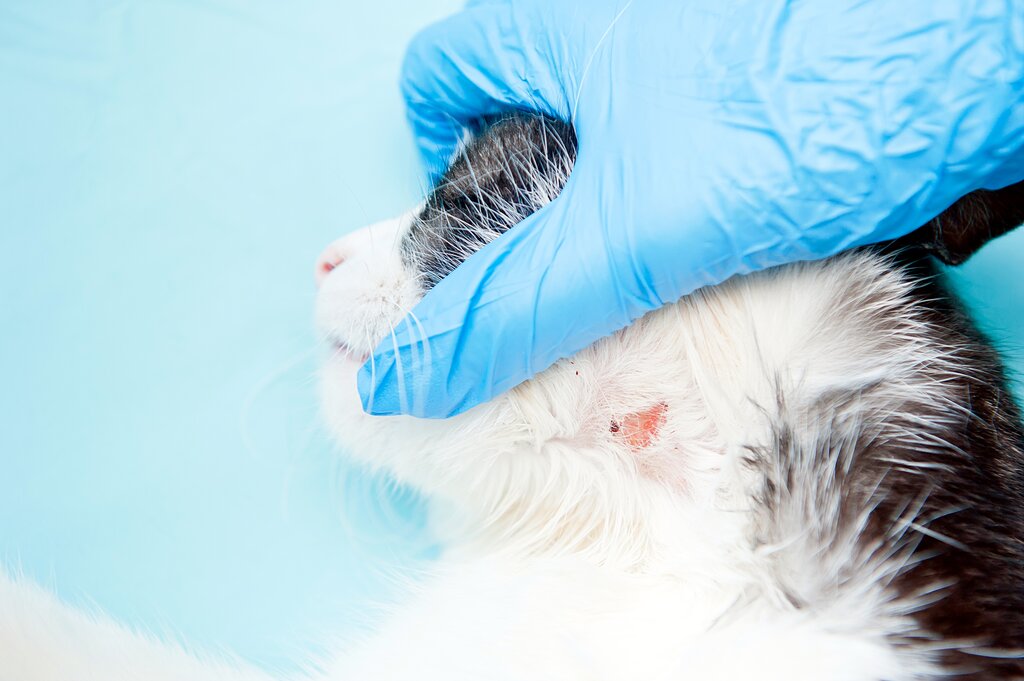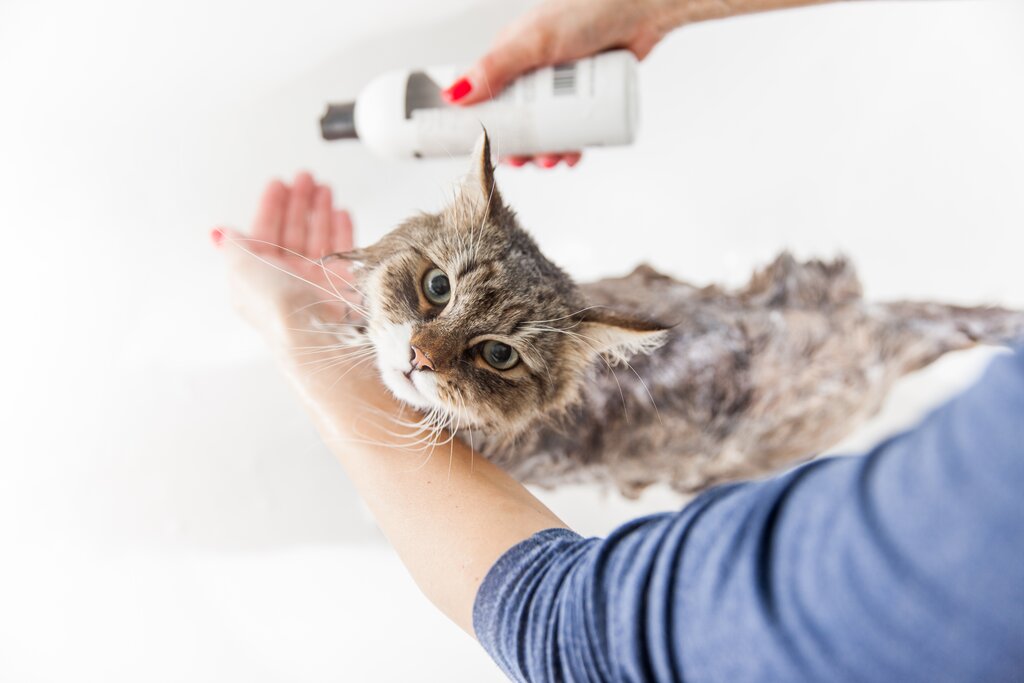Last Updated: 18/06/2025
Ringworm In Cats: Symptoms, Causes & Treatment
Ringworm is a common causes of skin condition in cats. Find out more about symptoms causes and treatment here.
Author: Dr Carla Paszkowski BVSc (Hons)
Reading Time: 28 minutes - medium read
Ringworm (feline dermatophytosis) is one of the most common causes of skin infection in cats all over the world. Causing itchy, scaley, red lesions on most mammals (including humans), this irritating infection is usually worst in the young or immunocompromised. Kittens, children, and allergy sufferers (both feline and human) are usually the worst affected by ringworm. Thankfully, the issue is easily treated and doesn't cause serious disease unless a secondary germ takes advantage of the infection.
What is Ringworm?

Is ringworm a worm? Despite its name, Ringworm is not a worm! Ringworm is actually caused by a fungus. (Perhaps it would be better named 'Ringus'!) The only thing it has to do with rings is the typical circular area of dry, scaley rash that usually appears on the animal.
The fungal pathogen responsible for ringworm is a commensal organism found on healthy skin, but only causes disease when it grows in too great a quantity, or if the skin or immune system is comprimised and can't fight it off. The pathogen that causes ringworm is also responsible for 'athlete's foot'.
In cats, about 98% of ringworm cases are caused by a species of fungus called Microsporum canis, however it may be caused by any species of Microsporum, Nannizzia, or Trichophyton fungi.2 These types of fungi are invisible to the naked eye, but can be seen under a microscope.
How do cats get ringworm?
The Ringworm fungi spread easily in the environment. It is primarily spread via contact with an infected host (be it feline, human, or another mammal such as a dog) or by touching contaminated objects like furniture, towels or grooming tools. Broken hairs that contain the fungal spores are a common source of spreading ringworm. Spores may survive in the environment for up to a year.1
As with many diseases, direct contact does not always result in infection. The development of lesions depends on host factors - particularly age, immune system health, skin quality, hygeine, and nutrition. This is why the disease is commonly seen in kittens, stressed cats, pregnant cats, or those with skin allergies. Interestingly, Persian cats may be predisposed to developing ringworm. It is unclear, however, whether FIV-infected cats are more susceptible to ringworm.4 Likewise, children, pregnant women, the elderly, and immunocompromised people (such as those with HIV or eczema) are more commonly affected.
Where did my kitten catch ringworm? As stated previously, the Ringworm fungus is a commensal organism that grows on the skin naturally, so your kitten may be exposed anywhere or from anywone. However, kittens are often exposed to larger quantities of the fungus in environments such as a shelter, cattery, pet store or breeder - which may concurrently be a stressful environment for the kitten and therefore compromises their already fragile immune system.
Cat ringworm in humans
Ringworm is transmissible between pets and humans. While cats can transmit ringworm to humans, in fact, many cats are actually infected by children in the household who have been infected at school or day care. (And unfortunately, often the cat is blamed for passing it to the child, rather than the other way around!)
If you or your child has been diagnosed with ringworm infection, don't panic - the disease is fairly easy to treat. (See our treatment section below)! You certainly shouldn't get rid of your cat or remove them from your house temporarily - this will only stress your cat and therefore make them less likely to recover. Remember that a strong immune system can usually fight off ringworm fungus on its own, so never under estimate the power of good nutrition, rest, cat probiotics, and Omega fatty acids (such as fish oil) for cats alongside medical and environmental treatment!
Symptoms of Ringworm in Cats
Ringworm usually produces red, inflamed, ring-like lesions with a scabby or bald centre, or thumbprint-shaped scabby lesions. However ringworm can also present as generalised, dry, scaly, or sparsely haired skin. In cats, it can affect any part of the body but is particularly common over the head and face. In humans, lesions usually present as ring-like or thumbprint-shaped red lesions. In both cats and humans, lesions may or may not be itchy.
Common Signs of Ringworm in Cats
- Inflamed, ring-like lesions on the skin
- Itchy skin
- Scaly, dry appearance to the skin with dandruff
- Hairless patches
- Crusty lesions - particularly around the nose, face, or ears
How to tell if my cat has ringworm? Ringworm needs to be diagnosed by a vet before choosing a treatment. This is particularly important because some bacterial infections and parasites can appear similar to ringworm but require a different treatment. To diagnose ringworm, your vet may do a microscope examination of your pet's skin scraping or fur, and they may also use a Wood's Lamp to observe the fur for flourescence. A Wood's lamp is a special UVA-A light and infected hairs can fluoresce ('light up') under its light. While some ringworm fungal species may not flouresce, a Wood's Lamp can be useful because Microsporum canis will always flouresce and this is the main clinically relevant fluorescing veterinary dermatophyte.3
Treatment of Ringworm in Cats

Although ringworm in most healthy animals will clear up on its own, treatment is recommended due to the contagious nature of the disease and its ability to spread to humans.5 A combination of topical and environmental treatment is ideal - and oral medication may be required in certain circumstances.
1. Clean the environment
Ringworm can persist in your home environment for months or even a year. Getting rid of it requires extensive sterilisiation and cleaning of your home and all bedding. Environmental decontamination involves cleaning to remove as much hair and debris as possible, and then disinfecting surfaces to kill any remaining spores.
How to get rid of ringworm in your home:
- Remove hairs. Use electrostatic wipes, lint rollers, or a strong vacuum to remove hairs from furniture, carpet, bedding, clothing, and other surfaces.
- Disinfect surfaces. F10 Veterinary Disinfectant or Sodium hypochlorite (chlorine bleach) diluted 1:10 and 1:32 is suggested as it has good antifungal activity.
- Clean your carpets. You may wish to use a carpet shampoo or a carpet disinfectant - however keep your pets off the carpet until they are completely dry as wetting carpets can cause sporulation.6
- Launder sheets and clothes. Use a hot wash to clean any exposed sheets or clothing and spray the machine after use with a diluted bleach.
2. Treat your cat's ringworm
To clear up the infection on your cat, ringworm requires topical treatments. Ringworm should be treated with an antifungal lotion containing medication such as miconazole (Fungafite) or iodine (Troy Iodin Spray), as well as 2-3 times per week washing with an antifungal shampoo containing miconazole such as Malaseb.
It's important to keep in mind that ringworm may require weeks, or even months, of strict treatment. Never stop treatment before your vet has given you the 'OK'!
3. Additional skin and immunity support
Remember - a healthy immune system and skin barrier will be able to fight off ringworm by itself with time, so whatever you can do to help support your cat's skin health is beneficial. This might include supplementing with Omega Fatty Acids (my top recommendation for cats is Megaderm Nutritional Supplement), introducing a cat probiotic or swapping to a premium quality pet food if you aren't already feeding one.
4. Address stress and anxiety
Tying in with extra immune support as outlined above, it's vital to reduce stress for your kitty while they recover. Cats are extremely prone to stress - in fact any change at home such as moving house, a new pet, or visitors to the home can push cats into stress-induced cystitis! - and every health issue can worsen if your cat is suffering from anxiety. The best treatment for anxiety in cats does vary depending on the situation, but a good place to start is by allowing your cat plenty of safe, secluded and quiet hiding spots, investing in a Feliway Diffuser, and following the steps in my article below:
For more tips on treating stress and anxiety in your feline friend, see our article How To Reduce Anxiety in Cats.
5. Treat your family if you have lesions
. If you or your family members have lesions, it's best to seek the advice of your doctor - and get a proper diagnosis to ensure they are actually ringworm lesions. The typical treatment for humans is very similar to cats; ie, topical creams and iodine or miconazole-based washes combined with environmental cleaning and good hygeine. As with cats, it can help to support your immune system and skin barrier with good nutrition (particularly Vitamin E, C, D, Omega Fatty Acids, probiotics, and plenty of water!)
Top Recommended Products
Further Reading
History
Our experts continually monitor the health and wellness space and we update our articles when new information becomes available.
Wed Feb 9 2022
Written by Dr Carla Paszkowski BVSc (Hons)Dr Carla Paszkowski BVSc (Hons)
Veterinarian
Dr. Carla graduated from the University of Queensland in 2013 with a Bachelor of Veterinary Science and worked for a number of years in small animal clinics across South East Queensland. While Carla enjoys most facets of clinical veterinary work, she holds a special passion for feline medicine, pocket pets, and nutrition.

